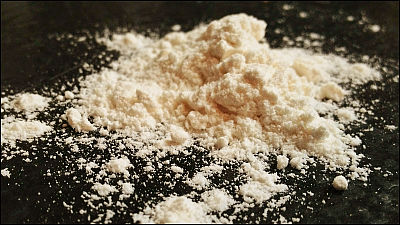'Insects' will soon come to the table

In Japan there are cultures that eat insects such as locusts, silkworm pa - ta and silkworm child in some areas, but insects are expected as an important protein source even in the world where food shortages are screamed. Bloomberg introduces a variety of data on edible insects that edible insects will soon decorate the table for ordinary households.
Bugs Are Coming Soon to Your Dinner Table
https://www.bloomberg.com/graphics/2018-insects-as-food/
The Shikonen family of livestock farmers lasting 500 years in southern Finland has been raising pigs so far but has started to cultivate six legged insects and crickets to solve the world food crisis. As the income from pig breeding gradually declined, Shikonen couple decided to convert pig farms that were breeding 1,200 pigs to temperature-controlled cricket farms. The target production volume of the cricket farm of Shikonen couple in 2018 is 1,500 kg. Many of the crickets produced are used as raw materials for chocolate, crisp · bread , bar snack, granola etc.
Shikonen couple who turned from a pig farm to a cricket cricket field. Mr. Kirsi on the left and Doko on the right.
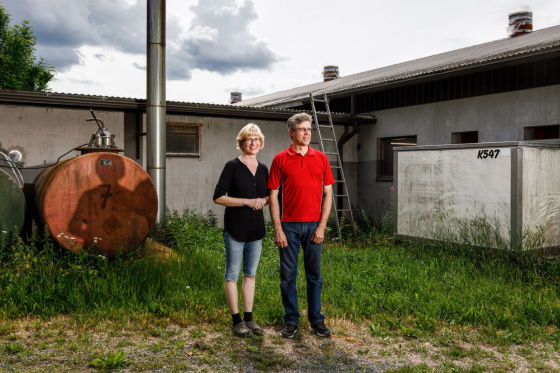
Mr. Kirsi giving a cereal mixture as a feed in a crickling breeding space said, "There is no heavy work and few smells as there is no need to gather fertilizer in cricket farming," he says. "Compared to work at a pig farm Physically easy, cricket does not chew, but pigs chew from curiosity, "he said, stating that the burden of work has been reduced more than at pig farming.
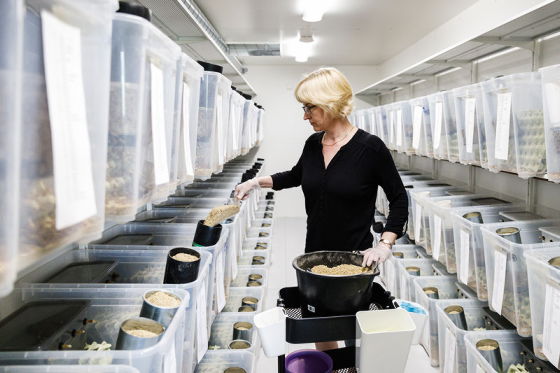
It is not only that the cricket farming is superior because it requires less labor as a work. Insects such as crickets have already become part of the dietary life of 2 billion people mainly in Asia and there is also a difference in the clouds and muds compared with the environmental and social costs when producing beef, pork and chicken. The area of the site necessary for cultivation of crickets is much smaller than that of cattle, pigs and chickens, and the amount of greenhouse gases emitted by breeding is also overwhelmingly small.
The following figure compares the breeding of insects with chickens, pigs and cows at four points. It shows insects, chickens, pigs, cows from the left of the column, the amount of greenhouse gas discharged to produce 1 kg, "feed necessary for producing 1 kg," "1 g of protein It shows the site area (square meter) necessary for production "and" the amount of water (liter) necessary to produce 1 g of protein ". It is obvious that cultivation of insects is friendly to the global environment and costs are low.
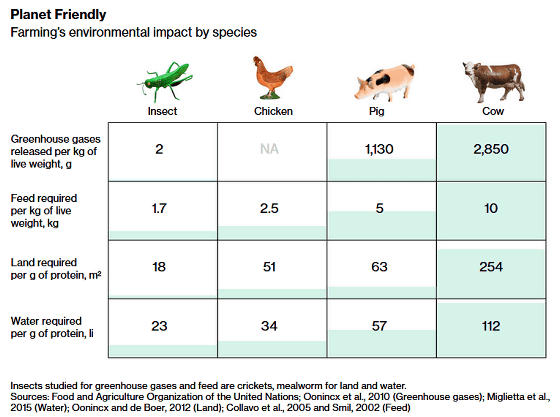
Crickets raised in plastic containers
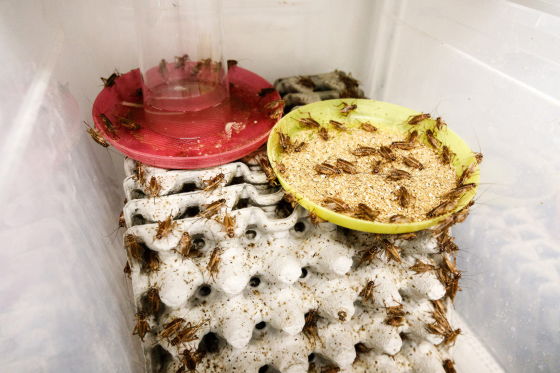
According to the US Food and Drug Administration (FDA), the diet required to keep 1 kg of cricket is less than 1/5 of the diet required to keep the same amount of cattle. Also, insects do not consume much water, and there is also a feature that there is no need to give antibiotics or growth hormone.
The following figures show the number of edible insects inhabited worldwide. It seems that there are about 50 to 100 edible insect species living in Japan.
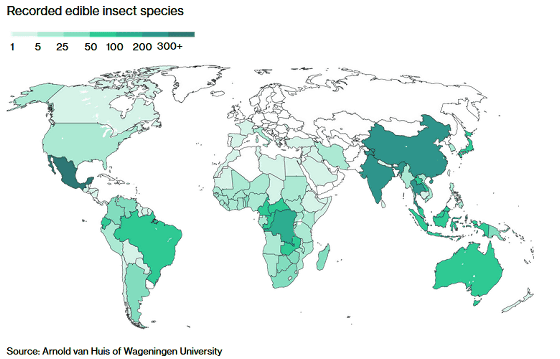
There are about 1900 kinds of insects used in traditional meals around the world, and there are large insect markets in Thailand · Japan · China · Australia · Peru etc. In addition, insects are becoming to be able to eat as 'unusual special products and restaurant menu' in Europe and the United States.
A famous Finnish chef opened in Helsinki " Restaurant Ultima " offers a small tart with topped truffle mayonnaise and cricket which fries crushed, and even in the restaurant "Fat Lizard" located in Espoo in southern Finland, fried crickets It seems that dishes that eat octopus, lime, and chili are getting popular.
Crickets are basically almost tasteless, so you can easily add them as foodstuffs such as sausages, cookies, muffins, tofu and ice cream. In addition, cricket powder also has a feature that it contains more protein than wheat flour used to make bread.
The following figure shows a graph showing nutrients per 100 g of crickets, chickens, pigs, and cattle. Rampant shows protein, iron content, saturated fat content from above. The amount of protein per 100 g is not so different, but you can see that the crickets are overwhelmingly iron-containing.
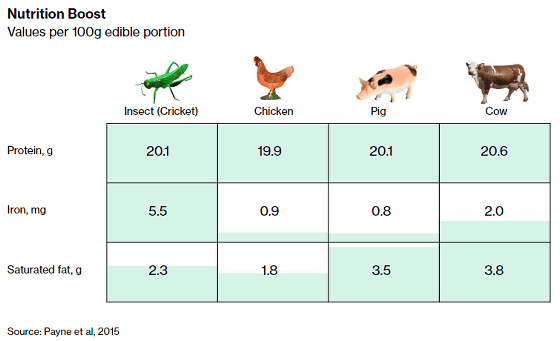
"Many people are afraid of eating insects, but they can not be turned into flour," said Radek Hasek, co-founder of SENS Foods, a cricket powder maker for bread. To support it, the world's food insect market is forecast to be about 1,180 million dollars (about 130 billion yen) about three times over the next five years, researching at Arcluster, a consulting firm based in Singapore Director Arun Nirmal said, "Because the industry raised the prospects for new investment and demand, production capacity has increased significantly since the second half of 2017."
The following graph shows forecast data of the edible insect market divided for each region of the world. The data of 2018 and 2023 are shown, and expansion of the market is expected around the world, especially in the Asian region, a tremendous growth is expected.
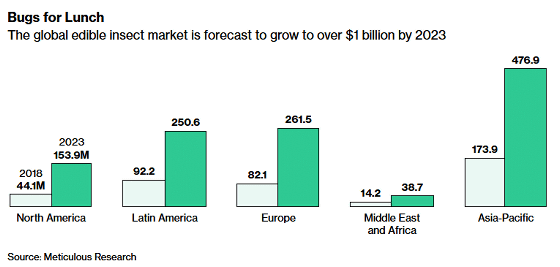
In addition, farmed crickets are frozen once for shipment and collected on EntoCube . And EntoCube brings it to Helsinki's food processing factory, it is cleaned, boiled, dried and crushed. There are about 20 small insect farms in Finland now, according to EntoCube more than 200 Finnish farmers are interested in insect breeding business which is not influenced by the weather. In addition, noodles made from insects are already on sale in supermarkets in Germany, and in Spain insects are used in more than 10 kinds of products such as energy bars and granola. In addition, crickets are traded at about 5 euros (about 650 yen) per kg in Thailand, whereas in the U.S. and European countries, the crickets are traded at a high price of 20 to 40 euros (about 2600 to 5200 yen) per kg.
Related Posts:




